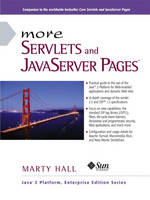
More Servlets and JavaServer Pages (JSP)
Prentice Hall (Verlag)
978-0-13-067614-6 (ISBN)
- Titel ist leider vergriffen;
keine Neuauflage - Artikel merken
Marty Hall's Core Servlets and JavaServer Pages was last year's #1 servlet/JSP book -- helping over 100,000 Java developers master the power of Java server-side programming to Web-enable an extraordinary range of applications. Now, Hall takes the next step, bringing together even more powerful servlet/JSP techniques. After a quick review of the basics, Hall presents in-depth coverage of the latest servlet and JSP capabilities incorporated in JDK Version 1.4, including filters, application events, and enhancements to JSP's XML support. Next, Hall moves on to Web application development, introducing the latest Servlet 2.3/JSP 1.1 features, and offering in-depth coverage of the Web Application Deployment Descriptor. More Servlets and JavaServer Pages includes a comprehensive section introducing the new tag library features incorporated in JSP 1.2, including a full chapter on Apache tag libraries. Hall concludes with an exceptionally comprehensive library of techniques for performance optimization, from caching to content compression, metering and connection pooling to changing JVM parameters.
The book also includes a full chapter on Web application security, as well as a start-to-finish case study application.
MARTY HALL is president of coreservlets.com, a training and consulting company focusing on server-side Java technology. He has taught training courses and seminars on servlet and JSP technology in the United States, Canada, Australia, Japan, and the Philippines. He is the author of the best-selling books Core Servlets and JavaServer Pages and Core Web Programming.
Acknowledgments.
About the Author.
Introduction.
Who Should Read This Book.
Book Distinctives.
Integrated Coverage of Servlets and JSP. Real Code. Step-by-Step Instructions. Server Configuration and Usage Details.
How This Book Is Organized.
I. The Basics. II. Web Applications. III. Web Application Security. IV. Major New Servlet JSP Capabilities. V. New Tag Library Capabilities.
Conventions.
About the Web Site.
I. THE BASICS.
1. Server Setup and Configuration.
Download the Java Development Kit (JDK). Download a Server for Your Desktop. Change the Port and Configure Other Server Settings. Test the Server. Try Some Simple HTML and JSP Pages. Set Up Your Development Environment. Compile and Test Some Simple Servlets. Establish a Simplified Deployment Method. Deployment Directories for Default Web Application: Summary.
2. A Fast Introduction to Basic Servlet Programming.
The Advantages of Servlets Over “Traditional” CG. Basic Servlet Structure. The Servlet Life Cycle. The Client Request: Form Data. The Client Request: HTTP Request Headers. The Servlet Equivalent of the Standard CGI Variables. The Server Response: HTTP Status Codes. The Server Response: HTTP Response Headers. Cookies. Session Tracking.
3. A Fast Introduction to Basic JSP Programming.
JSP Overview. Advantages of JSP. Invoking Code with JSP Scripting Elements. Structuring Autogenerated Servlets: The JSP page Directive. Including Files and Applets in JSP Documents. Using JavaBeans with JSP. Defining Custom JSP Tag Libraries. Integrating Servlets and JSP: The MVC Architecture.
II. WEB APPLICATIONS.
4. Using and Deploying Web Applications.
Registering Web Applications. Structure of a Web Application. Deploying Web Applications in WAR Files. Recording Dependencies on Server Libraries. Handling Relative URLs in Web Applications. Sharing Data Among Web Applications.
5. Controlling Web Application.
Behavior with web.xml. Defining the Header and Root Elements. The Order of Elements within the Deployment Descriptor. Assigning Names and Custom URLs. Disabling the Invoker Servlet. Initializing and Preloading Servlets and JSP Pages. Declaring Filters. Specifying Welcome Pages. Designating Pages to Handle Errors. Providing Security. Controlling Session Timeouts. Documenting Web Applications. Associating Files with MIME Types. Locating Tag Library Descriptors. Designating Application Event Listeners. J2EE Elements.
6. A Sample Web Application: An Online Boat Shop.
General Configuration Files. The Top-Level Page. The Second-Level Pages. The Item Display Servlet. The Purchase Display Page.
III. WEB APPLICATION SECURITY.
7. Declarative Security.
Form-Based Authentication. Example: Form-Based Authentication. BASIC Authentication. Example: BASIC Authentication. Configuring Tomcat to Use SSL.
8. Programmatic Security.
Combining Container-Managed and Programmatic Security.
Example: Combining Container-Managed and Programmatic Security. Handling All Security Programmatically. Example: Handling All Security Programmatically. Using Programmatic Security with SSL. Example: Programmatic Security and SSL.
IV. MAJOR NEW SERVLET AND JSP CAPABILITIES.
9. Servlet and JSP Filters.
Creating Basic Filters. Example: A Reporting Filter. Accessing the Servlet Context from Filters. Example: A Logging Filter. Using Filter Initialization Parameters. Example: An Access Time Filter. Blocking the Response. Example: A Prohibited-Site Filter. Modifying the Response. Example: A Replacement Filter. Example: A Compression Filter. The Complete Filter Deployment Descriptor.
10. The Application Events Framework.
Monitoring Creation and Destruction of the Servlet Context. Example: Initializing Commonly Used Data. Detecting Changes in Servlet Context Attributes. Example: Monitoring Changes to Commonly Used Data. Packaging Listeners with Tag Libraries. Example: Packaging the Company Name Listeners. Recognizing Session Creation and Destruction. Example: A Listener That Counts Sessions. Watching for Changes in Session Attributes. Example: Monitoring Yacht Orders. Using Multiple Cooperating Listeners. The Complete Events Deployment Descriptor.
V. NEW TAG LIBRARY CAPABILITIES.
11. New Tag Library Features in JSP 1.2.
Using the New Tag Library Descriptor Format. Bundling Listeners with Tag Libraries. Checking Syntax with TagLibraryValidator. Aside: Parsing XML with SAX 2.0. Handling Exceptions with the TryCatchFinally Interface. New Names for Return Values. Looping without Generating BodyContent. Introducing Scripting Variables in the TLD File.
12. The JSP Standard Tag Library.
Using JSTL: An Overview. Installing and Configuring JSTL. Looping with the forEach Tag. Accessing the Loop Status. Looping with the forTokens Tag. Evaluating Items Conditionally. Using the Expression Language.
Appendix: Server Organization and Structure.
Index.
| Erscheint lt. Verlag | 9.1.2002 |
|---|---|
| Verlagsort | Upper Saddle River |
| Sprache | englisch |
| Maße | 177 x 234 mm |
| Gewicht | 1099 g |
| Themenwelt | Informatik ► Programmiersprachen / -werkzeuge ► Java |
| Mathematik / Informatik ► Informatik ► Web / Internet | |
| ISBN-10 | 0-13-067614-4 / 0130676144 |
| ISBN-13 | 978-0-13-067614-6 / 9780130676146 |
| Zustand | Neuware |
| Haben Sie eine Frage zum Produkt? |
aus dem Bereich


